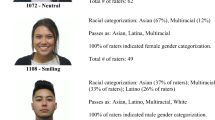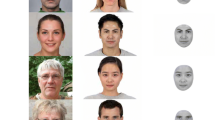Abstract
Complex social stimuli (like faces) can be studied using a methodology typically reserved for studying lights, tones, and colors: psychophysics. Given that psychophysics examines how humans detect and respond to stimuli in their environment, we can extend that to the study of how humans detect social stimuli in the environment. Using psychophysical methodology to answer “social” questions provides another dimension of experimental manipulation and control to the diverse array of methodologies already used by social psychologists. In this article, we review psychophysical methodology, provide a rationale for social psychophysics, describe an easy-touse software program called PsychoPro, for collecting psychophysical data, and present data collected using this program to examine racial thresholds that provide evidence for a cognitive gating mechanism for racial information that impacts face processing (MacLin & MacLin, 2007, in press; MacLin, MacLin, & Peterson, 2008).
Similar content being viewed by others
References
Abrosoft (2008). Abrosoft FantaMorph. Retrieved March 20, 2007, from www.fantamorph.com.
Anstis, S., & Paradiso, M. A. (1989). Programs for visual psychophysics on the Amiga: A tutorial. Behavior Research Methods, Instruments, & Computers, 21, 548–563.
Baker, P. M. (1977). On the use of psychophysical methods in the study of social status: A replication, and some theoretical problems. Social Forces, 55, 898–920. doi:10.2307/2577561
Beier, T., & Neely, S. (1992). Feature-based image metamorphosis. Computer Graphics, 26, 35–42. doi:10.1145/142920.134003
Bernstein, M. J., Young, S. G., & Hugenberg, K. (2007). The crosscategory effect: Mere social categorization is sufficient to elicit an own-group bias in face recognition. Psychological Science, 18, 706–712. doi:10.1111/j.1467-9280.2007.01964.x
Boynton, R. M. (1984). Psychophysics. In C. J. Bartleson & F. Grum (Eds.), Optical radiation measurements: Vol. 5. Visual measurements (pp. 335–366). Orlando, FL: Academic Press.
Brainard, D. H. (1997). The Psychophysics Toolbox. Spatial Vision, 10, 433–436.
Bruce, V., & Young, A. (1986). Understanding face recognition. British Journal of Psychology, 7, 305–327.
Chiroro, P., & Valentine, T. (1995). An investigation of the contact hypothesis of the own-race bias in face recognition. Quarterly Journal of Experimental Psychology, 48A, 879–894.
Chowdhry, O., Peterson, D. J., Lane, E., Leslie, D., MacLin, M. K., & MacLin, O. H. (2008, March). Perceptual discontinuities in the perception of other race faces: Implications for examining the crossrace effect. Paper presented at the annual meeting of the American Psychology-Law Society, Jacksonville, FL.
Chowdhry, O., Peterson, D. [J.], MacLin, M. K., & MacLin, O. H. (2007, November). Special image morphing techniques used to examine the effects of racial markers in racial categorization. Paper presented at the annual meeting of the Society for Computers in Psychology, Long Beach, CA.
Corneille, O., Huart, J., Becquart, E., & Brédart, S. (2004). When memory shifts toward more typical category exemplars: Accentuation effects in the recollection of ethnically ambiguous faces. Journal of Personality & Social Psychology, 86, 236–250. doi:10.1037/0022-3514.86.2.236
Correll, J., Urland, G. R., & Ito, T. A. (2006). Event-related potentials and the decision to shoot: The role of threat perception and cognitive control. Journal of Experimental Social Psychology, 42, 120–128. doi:10.1016/j.jesp.2005.02.006
Davis, J. A. (1963). Intellectual climates in 135 American colleges and universities: A study in “social psychophysics.” Sociology of Education, 37, 110–128.
Dercole, K. L., & Davenport, W. G. (1974). Social psychophysics: Measurement of attitudes toward violence. Perceptual & Motor Skills, 38, 135–145.
Dixon, M. R., & MacLin, O. H. (2003). Visual basic for behavioral psychologists. Reno, NV: Context Press.
Fechner, G. (1966). Elements of psychophysics (Vol. 1) (H. E. Adler, trans.; D. H. Howes & E. G. Boring, Eds.) New York: Holt, Rinehart & Winston. (Original work published 1860) doi:10.1037/11304-026
Finney, D. J. (1947). Probit analysis. Cambridge: Cambridge University Press.
Gescheider, G. A. (1997). Psychophysics: The fundamentals (3rd ed.). Mahwah, NJ: Erlbaum.
Golby, A. J., Gabrieli, J. D. E., Chiao, J. Y., & Eberhardt, J. L. (2001). Differential responses in the fusiform region to same-race and otherrace faces. Nature Neuroscience, 4, 845–850. doi:10.1038/90565
Harley, E. M., & Loftus, G. R. (2000). MATLAB and graphical user interfaces: Tools for experimental management. Behavior Research Methods, Instruments, & Computers, 32, 290–296.
Hart, A. J., Whalen, P. J., Shin, L. M., McInerney, S. C., Fischer, H., & Rauch, S. L. (2000). Differential response in the human amygdala to racial outgroup vs. ingroup face stimuli. NeuroReport, 11, 2351–2355.
Innocence Project (2008). The Innocence Project. Retrieved March 19, 2007, from www.innocenceproject.org/.
Ito, T. A., Thompson, E., & Cacioppo, J. T. (2004). Tracking the timecourse of social perception: The effects of racial cues on event-related brain potentials. Personality & Social Psychology Bulletin, 30, 1267–1280. doi:10.1177/0146167204264335
Jackson, J. M., & Latané, B. (1981). All alone in front of all those people: Stage fright as a function of number and type of co-performers and audience. Journal of Personality & Social Psychology, 40, 73–85. doi:10.1037/0022-3514.40.1.73
Joshi, P., Peterson, D. J., MacLin, M.. K.., & MacLin, O. H.. (2007, November). A computerized system to examine the perception of race and skin tone using racial markers. Paper presented at the annual meeting of the Society for Computers in Psychology, Long Beach, CA.
Krantz, J. H., Ballard, J., & Scher, J. (1997). Comparing the results of laboratory and World Wide Web samples on the determinants of female attractiveness. Behavior Research Methods, Instruments, & Computers, 29, 264–269.
Kurzban, R. (2001). The social psychophysics of cooperation: Nonverbal communication in a public goods game. Journal of Nonverbal Behavior, 25, 241–259. doi:10.1023/A:1012563421824
Levin, D. T., & Banaji, M. R. (2006). Distortions in the perceived lightness of faces: The role of race categories. Journal of Experimental Psychology: General, 135, 501–512. doi:10.1037/0096-3445.135.4.501 MacLin,
MacLin, O. H.. (2007, November). Psychophysical techniques examining the social psychology of race and racial identifications. Symposium presented at the annual meeting of the Society for Computers in Psychology, Long Beach, CA.
MacLin, O. H., Dixon, M. R., & Jackson, J. W. (2007). Visual Basic 2005 for psychologists. Reno, NV: Context Press.
MacLin, O. H., & MacLin, M.. K. (2007, November). Using PsychoPro to examine social psychological phenomena. Paper presented at the annual meeting of the Society for Computers in Psychology, Long Beach, CA.
MacLin, O. H., & MacLin, M.. K. (in press). The role of racial markers in race perception and racial categorization. In R. Adams, N. Ambady, K. Nakayama, & S. Shimojo (Eds.), People watching: The social ecology of visual perception. Oxford: Oxford University Press.
MacLin, O. H., MacLin, M.. K., & Peterson, D. (2008, March). Crossracial identification and classification: A cognitive gating mechanism for faces. Paper presented at the annual meeting of the American Psychology-Law Society, Jacksonville, FL.
MacLin, O. H., & Malpass, R. S. (2001). Racial categorization of faces: The ambiguous race face effect. Psychology, Public Policy, & Law7, 98–118. doi:10.1037/1076-8971.7.1.98
MacLin, O. H., & Malpass, R. S. (2003). The ambiguous-race face illusion. Perception, 32, 249–252. doi:10.1068/p5046
MacLin, O. H., & Webster, M. A. (2001). The influence of adaptation on the perception of distortions in natural images. Journal of Electronic Imaging, 10, 100–109.
Malpass, R. S., & Kravitz, J. (1969). Recognition for faces of own and other race. Journal of Personality & Social Psychology, 13, 330–334. doi:10.1037/h0028434
Meissner, C. A., & Brigham, J. C. (2001). Thirty years of investigating the own-race bias in memory for faces: A meta-analytic review. Psychology, Public Policy, & Law, 7, 3–35. doi:10.1037/1076-8971.7.1.3
Meltzer, L., Morris, W. N., & Hayes, D. P. (1971). Interruption outcomes and vocal amplitude: Explorations in social psychophysics. Journal of Personality & Social Psychology, 18, 392–402. doi:10.1037/ h0030993
Pelli, D. G. (1997). The VideoToolbox software for visual psychophysics: Transforming numbers into movies. Spatial Vision, 10, 437–442.
Phelps, E. A., O’Connor, K. J., Cunningham, W. A., Funayama, E. S., Gatenby, J. C., Gore, J. C., & Banaji, M. R. (2000). Performance on indirect measures of race evaluation predicts amygdala activation. Journal of Cognitive Neuroscience, 12, 729–738. doi: 10.1162/089892900562552
Phelps, E. A., & Thomas, L. A. (2003). Race, behavior, and the brain: The role of neuron imaging in understanding complex social behaviors. Political Psychology, 24, 747–758. doi:10.1046/j.1467-9221.2003.00350.x
Roby, T. B., & Budrose, C. R. (1966). Psychophysical scale matching as a prototypical language task. Journal of Personality & Social Psychology, 3, 675–684. doi:10.1037/h0023191
Smith, E. R., & Zárate, M. A. (1990). Exemplar and prototype use in social categorization. Social Cognition, 8, 243–262.
Snodgrass, J. G. (1975). Psychophysics. In B. Scharf (Ed.), Experimental sensory psychology (pp. 17–67). Glenview, IL: Scott, Foresman.
Sporer, S. L. (2001). Recognizing faces of other ethnic groups: An integration of theories. Psychology, Public Policy, & Law, 7, 36–97. doi:10.1037/1076-8971.7.1.36
Stern, S. E., Mullennix, J. W., Corneille, O., & Huart, J. (2007). Distortions in the memory of the pitch of speech. Experimental Psychology, 54, 148–160. doi:10.1027/1618-3169.54.2.148
Stevens, S. S. (1936). A scale for the measurement of a psychological magnitude: Loudness. Psychological Review, 43, 405–416. doi:10.1037/h0058773
Steyvers, M. (1999). Morphing techniques for manipulating face images. Behavior Research Methods, Instruments, & Computers, 31, 359–369.
Thurstone, L. L. (1931). The measurement of social attitudes. American Journal of Sociology, 23, 529–544. doi:10.1037/h0070363
Upshaw, H. S. (1962). Own attitude as an anchor in equal-appearing intervals. Journal of Abnormal & Social Psychology, 64, 85–96. doi:10.1037/h0048600
Valentine, T., Chiroro, P., & Dixon, R. (1995). An account of the own-race bias and the contact hypothesis in terms of a face space model of face recognition. In T. Valentine (Ed.), Cognitive and computational aspects of face recognition: Explorations in face space (pp. 69–94) London: Routledge.
Ward, J., & Liu, C. H. (2005). VRVision: A new tool for the display of 3-D images in behavioral research. Behavior Research Methods, 37, 464–469.
Webster, M. A., Kaping, D., Mizokami, Y., & Duhamel, P. (2004). Adaptation to natural facial categories. Nature, 428, 558–561. doi:10.1038/nature02420
Wenderoth, P. (1990). Software-based visual psychophysics using the Commodore Amiga with Deluxe Paint III. Behavior Research Methods, Instruments, & Computers, 22, 383–388.
Willadsen-Jensen, E. C., & Ito, T. A. (2006). Ambiguity and the timecourse of racial perception. Social Cognition, 24, 580–606. doi:10.1521/soco.2006.24.5.580
Wilson, P. R., & Russell, P. N. (1966). Modification of psychophysical judgments as a method of reducing dissonance. Journal of Personality & Social Psychology, 3, 710–712. doi:10.1037/h0023238
Zárate, M. A., & Smith, E. R. (1990). Person categorization and stereotyping. Social Cognition, 8, 161–185.
Zebrowitz, L. A. (1998). Reading faces: Window to the soul? Boulder, CO: Westview Press.
Author information
Authors and Affiliations
Corresponding author
Rights and permissions
About this article
Cite this article
MacLin, O.H., MacLin, M.K., Peterson, D. et al. Social psychophysics: Using psychophysics to answer “social” questions with PsychoPro. Behavior Research Methods 41, 623–632 (2009). https://doi.org/10.3758/BRM.41.3.623
Received:
Accepted:
Published:
Issue Date:
DOI: https://doi.org/10.3758/BRM.41.3.623




